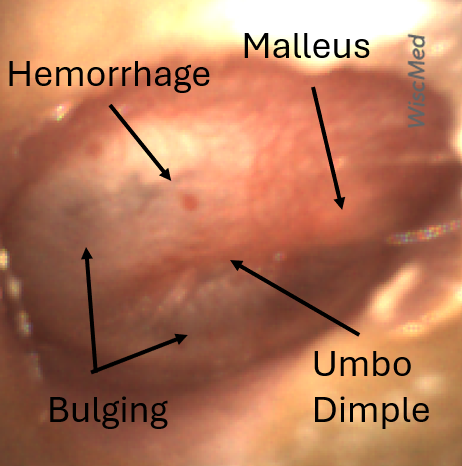
Acute Otitis Media – March 21, 2024
A 5-year-old male presents to the emergency department (ED) late in the evening with ear pain. His mother reports her son first reported ear discomfort two days prior, but he seemed fine after a dose of ibuprofen. She did not seek evaluation. This evening, he woke up crying and holding his right ear. When asked how much his ear hurts, he replies “really, really bad”. In the ED, he is afebrile and has normal age-appropriate vital signs. Aside from being tearful, he appears well without any other significant findings. His Wispr digital otoscope exam is shown.
Which of the following is/are true regarding this child’s presentation?
- The child does not have acute otitis media (AOM).
- His symptoms are severe, so management should include pain control and starting antibiotics immediately.
- His symptoms are mild, so management should include pain control and observation with follow-up if his symptoms persist beyond the next 48-72 hours.
- An urgent consult to otolaryngology (ENT) is indicated for consideration of ventilation (ear) tubes.
Answer: B
Management of children for acute otitis media is a three-step process: making the diagnosis, assessing severity, and determining the treatment.
1. Making the Diagnosis

The child’s Wispr exam demonstrates mild bulging and erythema (and a few small areas of hemorrhage) of the left tympanic membrane (TM). According to the AAP Practice Parameter, “clinicians should diagnose AOM in children who present with mild bulging of the TM and recent (less than 48 hours) onset of ear pain (holding, tugging, rubbing of the ear in a nonverbal child) or intense erythema of the TM.”
While moderate to severe bulging is readily apparent as the TM demonstrates the “donut sign”, mild bulging is less obvious. However, a closer look at the TM allows one to discern findings that give the TM a “full” appearance in mild bulging: a dimple centrally (where the umbo is a fixed attachment) and difficulty visualizing the malleus superiorly (where the pars flaccida is the first portion of the TM to bulge outward).
Thus, the child has acute otitis media (AOM).
2. Assessing Severity
Severity is determined by the duration of symptoms, degree of pain, and height of fever. According to the AAP Practice Parameter, severe signs or symptoms include moderate or severe otalgia, otalgia for at least 48 hours, or temperature 39°C or higher. In the current case, his symptoms were assessed as being severe given that ear discomfort started two days prior and seemed to be worsening.
3. Determining Treatment
Treatment always includes the management of pain, so oral and topical analgesics should be recommended. Initiating antibiotics depends on the severity, uni- versus bilateral involvement, and age. The AAP recommends treating all severe AOM immediately, regardless of age or laterality, thus immediate initiation of antibiotics would be most appropriate in the current case.
Since the child has no history of recurrent AOM, there is no indication for referral to ENT for ventilation tubes.
WiscMed has created a visual guide to ear conditions that can be found here. In addition, here is a guide to AAP recommendations for AOM.
Here is the complete video exam.
Reference:
Lieberthal, et al. The Diagnosis and Management of Acute Otitis Media. Pediatrics (2013) 131 (3): e964–e999.








































































































































































































